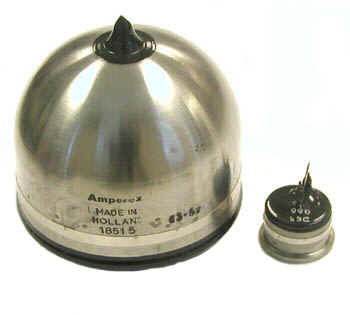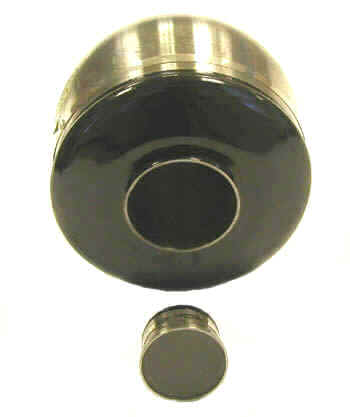Amperex Low-Level Beta Counter (ca. 1960)
The need to measure the low level radiation associated with radioactive contamination in air, water, food, etc., led to the development of this low background Geiger-Mueller counter.
The key to the system's performance is the hemispherical/cup-shaped Type 18517 guard tube (ca. 3" in diameter and 3" high). Its unique shape surrounds the Model 18515 end window GM detector on all sides—a feat that would typically require the use of multiple tubes. Note that the guard tube in the photo is stamped with the wrong number—it should be 18517, not 18515. The combination of the anticoincidence shield and the use of detector materials containing very low levels of naturally occurring radionuclides resulted in a background of approximately 1 cpm (assuming a conventional 400 pound lead shield is also used).


The manufacturer claimed: "The cosmic ray efficiency of the guard counter is virtually 100%. Thus no cosmic ray can actuate the inner tube without simultaneously actuating the guard counter." In operation, the small inner end window detector would respond to both the radiation from the sample and cosmic rays. The guard detector only responded to cosmic rays. Pulses produced by the end window detector would not be counted if there was a simultaneous pulse from the guard detector—these would be pulses due to cosmic rays. Pulses from the end window detector would be counted if there was no simultaneous pulse from the guard detector—these pulses would be due to radiation from the sample.
Detector: End window GM with hemispherical GM guard detector
Window: ca. 1" diameter; either 1.5-2.0 mg/cm² mica window or 8 mg/cm² steel window
Gas: Neon and argon mix, halogen quenched
Operating voltage: ca. 1000 volts
Dead Time: ca. 1000 usec
References:
- Advertisement, Nucleonics, June 1959.
- Amperex Nuclear Products catalog of radiation tubes, 1981.
